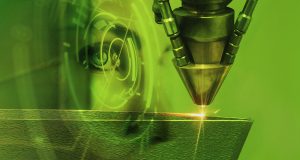
Directed Energy Deposition (DED) is an additive manufacturing process in which layers of material are deposited to produce metal, polymer, or ceramic parts. A laser or electron beam is used to melt each layer of the material—in powder or wire form—as it is deposited. Parts with very complex shapes that would be impossible to manufacture using conventional techniques can be obtained with DED. In fact, DED is rapidly gaining traction in the automotive, aeronautics, medical, and other industries that demand defect-free parts. List, a CEA Tech institute, recently developed an interferometry-based method for detecting even the tiniest microporosities and cracks during the DED process.
A pulsed laser generates elastic waves, both at the surface of and deep within the object being manufactured. Another laser detects these waves, with abnormal propagation indicating defects. The researchers successfully synchronized the probe-robot’s trajectory with that of the DED robot: So successfully that the system can detect defects measuring just a hundred microns.
This high-performance technology was unveiled at the Formnext trade show in Germany in November 2019, garnering interest from a number of potential industrial users. Additive manufacturing equipment maker Beam, LIST’s partner on the project, is currently planning to integrate the technology into its machines.
Read article at http://www.cea-tech.fr/